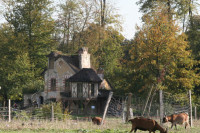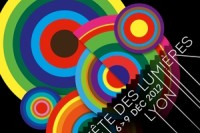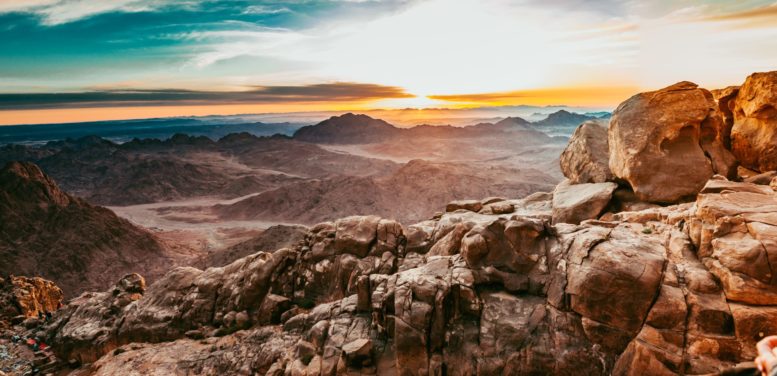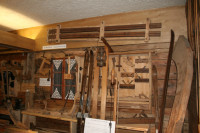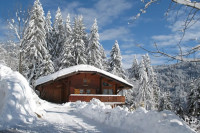Published articles
Summer in the Alps. Véronique Gray travels to the amazing valley of Chamonix in the French Alps
Véronique Gray travels to the amazing valley of Chamonix in the French Alps
If you have chosen to come to Chamonix this summer, you are bound to have a magical time. No matter what reasons bring you there: to enjoy the breathtaking sceneries, to hike some of the 350 km alpine trails or to climb a mountain; Chamonix has it all. It has never been easier to be closer to nature thanks to the many cable cars, gondolas and alpine trains.
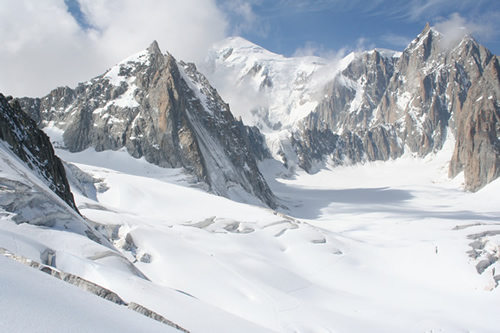
Vallée Blanche taken on the gondola to Helbronner
Refuges make it a nice alternative for those who prefer spending the night, making two hikes into a long one, rather than having to go back to their accommodation. It also makes it easier for sunrise and sunset lovers. No need to get up early or rush to catch the last cable car!
You could spend the next few summers exploring the region and always be positively surprised. But for this time around, here are three excursions, which shouldn’t be missed.
Why not go to the Aiguille of Midi, the most known of the Chamonix Aiguilles? It will be a lifetime experience for fans of mountain peaks and snowy vistas. It is the closest you will get to Mont Blanc if you are not intending to climb it.
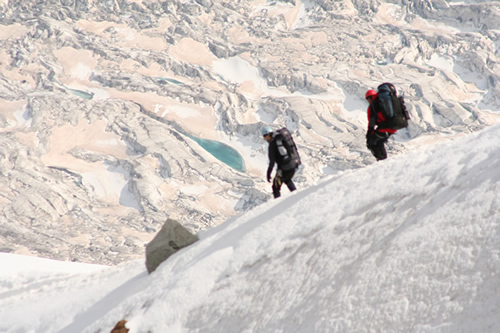
Climbing down the Aiguille du Midi, France
Imagine being at the highest European viewing point at 3,842m. On clear days, you will see the Chamonix Valley, its peaks, the Aravis Chain, the Bossons Glacier, high Swiss and Italian summits and much more.
Sunrises are just beautiful. Go as early as possible as in high altitude, weather changes quickly. Try making this excursion at the beginning of your journey if the weather allows it.
As it is the second most visited place in France after the Mont St. Michel, you should try reserving your cable space a day ahead to limit long waits. Half a million people go there yearly.
Reachable in 20 minutes with one stop, the cable car celebrated its 50th anniversary last year. Bringing this cable up was the task of a hundred men, who during four years carried everything on their back. A century after some guides had climbed the Aiguille, it was finally reachable by cable.
Early risers will find themselves mingled with international skiers, mountaineers and hikers. Summer skiing is possible on the Géant Glacier. Climbing the northern and southern side of the Aiguille is a popular activity.
Many are there for Mont Blanc. An estimated number of 300-400 alpinists leave daily to climb it. Afterall, Chamonix is the capital of alpinism, where it was born. The two chamoniards, Paccard and Balmat, were the first to reach it in 1786.
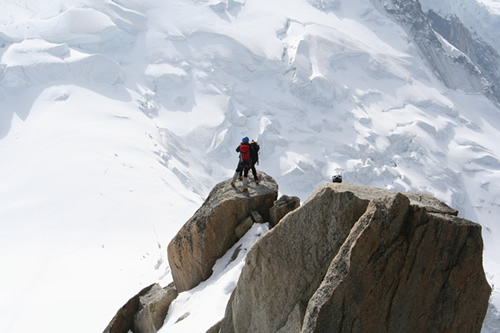
Enjoying the view after the climb, Aiguille du Midi
Experienced hikers cross the Vallée Blanche to the Ice Sea while other prefer a trip to Helbronner. Needless to say, for all mountaineering activities, a guide is strongly advised.
If you come mainly to observe the alpinists, you will have plenty of opportunities from the terraces and the outside tunnel leading to the Vallée Blanche.
Before returning to Chamonix I highly recommend taking a 30 minute gondola ride to the Italian Point Helbronner, reachable from the Aiguille of Midi. It will be such a memorable trip above the Vallée Blanche that you won’t mind the additional fee. The five stops allow visitors to view the gorgeous panorama, the alpinist camps, the Géant Glacier and its many deep crevasses.
MER DE GLACE
But what next? I suggest taking a train to the Montenvers site, where the Mer de Glace is found. You will not be alone; about 450,000 people made the trip last year.
The Mer de Glace is the longest French glacier and the second in Europe behind the Aletsch Swiss Glacier. Made of three glaciers (Glacier of Leschaux, Talèfre and Tacul), its look differs depending on where you stand. Crevasses, seracs, moraines and waves can be noticed.
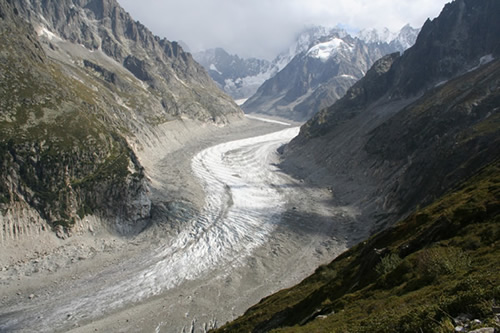
Mer de glace – walk to Montenvers
If tourists are pouring to the site today, it was not the case in 1741 when the two English explorers, William Windham and Richard Pocoke, arrived in the valley of Chamonix. Locals were scared to wander near glaciers. All believed it was haunted and only courageous hunters and crystal seekers adventured themselves there.
It all changed after their departure. Windham coined the word ‘Mer de Glace’ to commercialise the place and it worked out well. Unfortunately, the “Ice Sea” is melting rapidly, losing about 14 m yearly.
For years till the inauguration of the well-known red train in 1908, visitors travelled to Montenvers by donkey. Now, thanks to the rack-train, functioning all year but busier in summer months, it can be reached in twenty minutes instead of three hours.
When a few capitalists at the end of the 19th century proposed a railway, their project was not very well received. The Alps Magazine talks about “a foolish idea”. Fortunately it was built and noone regrets it. Standing outside of the Montenvers railway station at a 1913 m altitude, you will have an amazing view of the ice sea.
For a closer look, visit the ice grotto, whose inside blue walls are quite impressive. Since the past 60 years, a new grotto is dug each year due to glacier movements. About five men work at it while the other grotto is used for tourism. After so many decades with the same look, this year’s cave is being redesigned. “It will be equipped with niches and an optical fibre lighting system for special brilliance,” Fabienne Martinez at the Mont Blanc Company tells me.
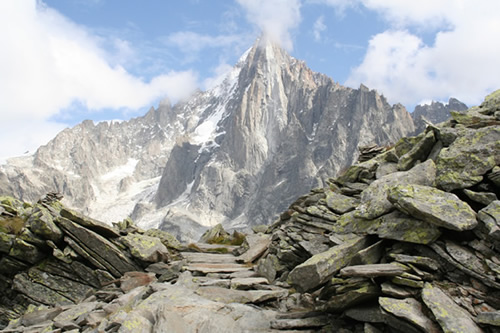
Rocky panorama on the Grand Balcon Nord Trail, Chamonix
The Montenvers site can also be reached by foot from Les Planards’parking lot. The hike takes about two and a half hours and goes mainly through the woods. Another walk, starting at the Plan de l’Aiguille, is a must if you have time. It lasts a bit longer and follows the Grand Balcon Nord trail, crossing streams and going along the Chamonix Aiguilles. For shorter walks, try the trail Signal Forbes from Montenvers and walk for about 40 minutes. Above the Grand Hotel lays a wonderful mountainous panorama and of course, the Mer de Glace.
FAIRY-TALE LAKE
My last recommendation is a hike to the Lac Blanc, a small alpine lake. Perched at 2352 m, the Lac Blanc is claimed to be the most beloved hike of those touring the region. Some describes the lake as a fairy-tale.
What is so special about it? With so much to see, hear and smell, it will be difficult to know where to give your attention. Depending on your arrival time, you may see marmots, ibex and chamois along the trail and near the lake. Observing the flight of royal eagles and other vultures such as the bearded vulture is also possible. Even if the bearded vulture doesn’t roost in the area, it is sometimes seen there.
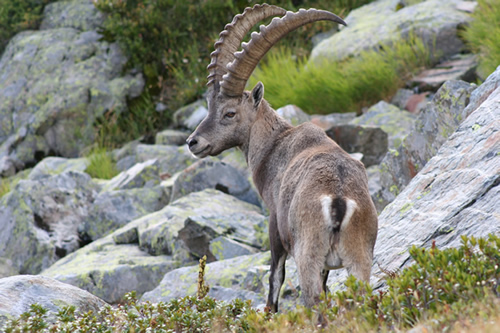
Ibex in the Aiguilles Rouges Reserve
The landscape changes along the path from snowy peaks, rocky panoramas with huge granite stones to lush alpine areas. Hikers will encounter beautiful flowers of various heights and colours such as the yellow lichens, purple pansies and pink rhododendrons bushes; with luck you will notice rare flowers such as edelweiss.
Where should you begin? Most start at the top of La Flégère or the Index cable car. Taking the second cable car reduces your waking time by 30 minutes.
I drove to Les Praz near Chamonix and took the most common trail starting at the Index. I followed the path, sometimes narrow, going up and down. It is a hike of average difficulty for the entire family, never dangerous, but one needs good mountain shoes. The path is accessible from the middle of June till the middle of October. Halfway through you enter the Aiguilles Rouges Reserve, so after this point, dogs are not allowed. The trail is known as the Grand Balcon Sud.
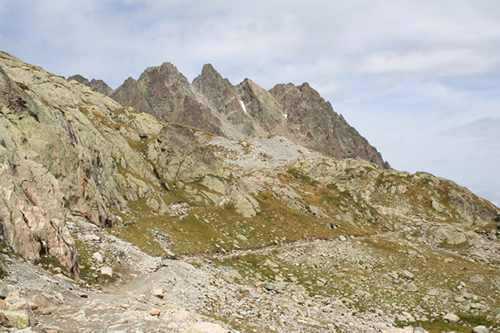
Aiguilles Rouges Reserve path on the way to the Lac Blanc
The scenery of the many glaciers, cliffs and Chamonix Aiguilles on the other side of the valley is grandiose and without any doubt will leave you speechless. Keep a map handy to refer to all places.
Without stopping, it takes about one and a quarter hour. The lake is a busy place and is the perfect place for a picnic while observing the clear, peaceful blue water. The refuge also offers drinks and some food, but nothing fancy.
During the month of August when the ice has finally melted, one can finally observe the reflections of the Mont Blanc Massif in the lake. This is the most precious moment and reward for all hikers. It isn’t uncommon to see patches of snow here and there around the lake.
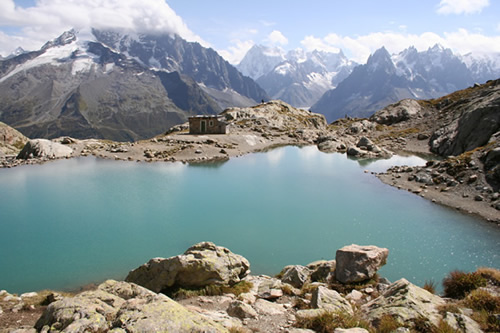
View of the Lac Blanc
If you are not tired and are experienced, you can continue hiking toward the Col des Dards or du Belvédère. It will be a good opportunity to be alone and discover hidden lakes.
To return, follow the sign to La Flégère. It takes about one hour. It is possible to go via the beautiful lakes of Chéserys. The best is probably to wait and decide after having reached the lake and enjoyed the scenery.
Hike to the Lac Blanc and you will soon understand why it is such an unbelievable place. “A hike cannot be described, it has to be experienced.”
PREPARING YOUR TRIP TO CHAMONIX
Tourist office
85 place du Triangle de l’amitié – BP 25
74401 Chamonix Mt Blanc Cédex
T: (0033) (0)4 50 53 00 24
F: (0033) (0)4 50 53 58 90
Haute Savoie Tourist Agency
T: (0033) (0)4 50 51 32 31
F: (0033) (0)4 50 45 81 99
www.savoiehautesavoie.com
HIKES
For itinaries and maps of hikes in Haute Savoie’s check out
www.randos-montblanc.com/pages/itineraire.html
FIND A GUIDE
www.chamonix-guides.comor email info@chamonix-guides.com
T : (0033) (0)4 50 53 00 58
F: (0033) (0)4 50 53 48 04
Cable car of La Flégère
Les Praz, 74400 Chamonix Mont-Blanc
T: (0033) (0)4 50 53 18 58
www.ohm-chamonix.com
WHERE TO STAY
Reservation: www.reservation.chamonix.com
or T: (0033) (0)4 50 53 23 33
Refuges: www.ohm-chamonix.com
Lac Blanc Refuge: contact Mr. Sage T: (0033) (0)4 50 53 49 14 or
(0033) (0)4 50 47 24 49
Open from Mid of June until the end of September
Grand Hotel Montenvers
July and August only. T: (0033) (0)4 50 53 87 70
F: (0033) (0)4 50 55 80 94
ANGLO-SAXON INTEREST IN THE ALPS
ALPINISTS: many of the first Mont Blanc climbers were British: 7 out of 20.
CHARLES BLAIR: sometime in the 1770’s he founded the first hospice at Montenvers, which was built for overnight visitors.
JAMES DAVID FORBES: Scottish glaciologist, known for his glacier theory
MARY SHELLEY: inspired by the glacier, she used the place in her book Frankenstein
WILLIAM WINDHAM: explorer of the Valley of Chamonix, who coined the phrase `Mer de Glace’
LEARN MORE
AIGUILLE: a French word meaning ‘needle’ and describing sharp peaks looking like needles. The Aiguilles Rouges (red needles) got its name from the reddish colour of the rocks when the sun shines.
ARAIGNÉE DU CIEL: literally ‘spider of the sky’; used to describe the men who worked on the Aiguille of Midi’s cable car, often hanging at high altitudes to complete the work.
GROTTUS: workers of the Mer de Glace grotto. Comes from grotte, meaning grotto or cave.
GLACIER DES BOIS: name of the Mer de Glace before Windham coined the term. The glacier used to go down to the village of des Bois.
PIRATES DE GLACE: before today’s guides, men used to help tourists cross the ice sea in exchange for money. Probably nicknamed pirates because of their personality and looks.

